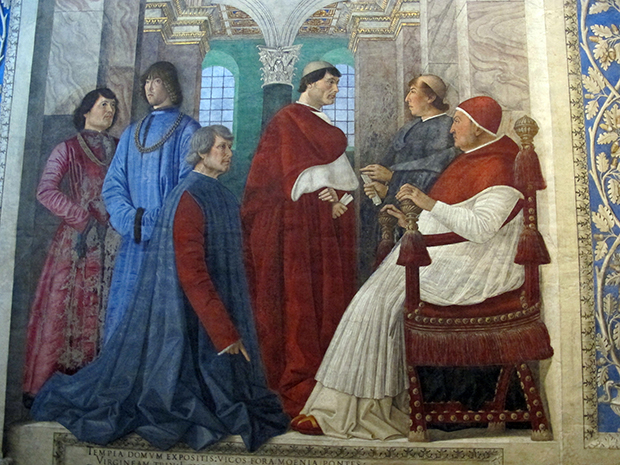Austerity: Platina, Martino and the New Cuisine

Bartolomeo Platina (third from left) features in this painting by Melozzo da Forlì
Now that every cookery writer in the land has been gloriously creative with Thanksgiving pumpkins and innovative with the Christmas dinner, and brutal with the leftovers, we can settle down to mutter darkly about austerity and ways of enjoying cheap deliciousness.
Perhaps that was why the humanists of the Italian Renaissance ostentatiously flaunted their simple tastes and frugal housekeeping, enjoying the contrast between the lavish banquets of the wealthy and the home life of poverty-stricken intellectuals?
But the exquisitely simple dishes we shall look at in a moment were also served up at banquets enjoyed by the rich and powerful – 15 to 20 dishes in a course, in a meal with maybe several courses, not a bit like the conventional structure of starters, mains and puddings that we are used to.
Mercifully, the guests would choose a bit of this and that, not chomp their way through the whole overwhelming list.
So a star turn like Maestro Martino’s chicken with verjuice would have made a nice family meal as well as banquet food.
Writer and gastronomist Bartolomeo Platina boasts of having enjoyed this at the table of Poggio Bracciolini, or maybe his son, who was one of the pioneers of Renaissance humanism in Florence.
Scholars and artists who wanted to get back to the simplicity and clarity of classical art explored sculpture, architecture and literature, and rescued treasures of art and philosophy from where they had been dumped during the obscurantist Middle Ages.
It was an exciting time for several generations, from Petrarch onwards, as new material was discovered, literature in manuscript, written in a lovely simple calligraphy, to wall paintings in the ruins of Roman villas, graffiti in the catacombs, and sculpture lurking in a cardinal’s backyard.
Greed and excitement fuelled the flames of scholarship and erudition, and so it’s no surprise that a brilliant cook like Martino should be employed by the powerful Ludovico Trevisan, Patriarch of Aquileia, who had a villa up in the Colli Romani, the hills outside Rome.
Trevisan was on visiting terms with the Cardinal Federico Gonzaga, once a pupil of Platina’s in Mantua and now his protector after a spat with Pope Paul II.
The presentation copy of Martino’s cookery book, dedicated to Trevisan, was written out by the foremost calligrapher of the time – Bartolomeo Sanvito – which gives us some idea of its importance, while Platina’s published version De honesta voluptate et valetudine, a sort of health handbook incorporating Martino’s recipes, became a bestseller.
It was in the year 1465 that this happy blend of circumstances and personalities came together in Marino, a little hill town in the Colli Romani, described so vividly by Bruno Laurioux in his vivid and painstaking study of Martino’s text, ‘a sonata for four hands’ rather than an appropriation of a cook’s recipes by an opportunist intellectual.
Sanvito’s calligraphy, ‘castigata et clara’ is the untranslatable Latin description used by Petrarch way back in 1366, a century earlier, of the ideal handwriting, as the worlds of art and literature rushed to embrace the new clarity and simplicity of the Greeks and Romans.
It’s pleasant to remind ourselves of Poggio Bracciolini, on one of these early manic expeditions to copy inscriptions, refreshing himself, like us, with the clean, cool, young white wine of Marino, glad to have escaped a boring stint in England where the weather, and the girls, were all so dreary.
